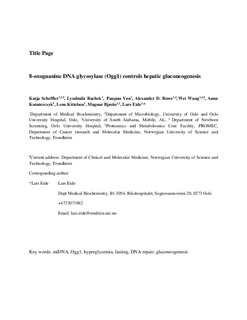| dc.contributor.author | Scheffler, Katja | |
| dc.contributor.author | Rachek, Lyudmila | |
| dc.contributor.author | You, Panpan | |
| dc.contributor.author | Rowe, Alexander D. | |
| dc.contributor.author | Wang, Wei | |
| dc.contributor.author | Kuśnierczyk, Anna | |
| dc.contributor.author | Kittelsen, Lene Svendsen | |
| dc.contributor.author | Bjørås, Magnar | |
| dc.contributor.author | Eide, Lars | |
| dc.date.accessioned | 2019-01-09T12:35:54Z | |
| dc.date.available | 2019-01-09T12:35:54Z | |
| dc.date.created | 2018-02-19T12:51:20Z | |
| dc.date.issued | 2018 | |
| dc.identifier.citation | DNA Repair. 2018, 61 56-62. | nb_NO |
| dc.identifier.issn | 1568-7864 | |
| dc.identifier.uri | http://hdl.handle.net/11250/2579955 | |
| dc.description.abstract | Mitochondrial DNA (mtDNA) resides in close proximity to metabolic reactions, and is maintained by the 8-oxoguanine DNA glycosylase (Ogg1) and other members of the base excision repair pathway. Here, we tested the hypothesis that changes in liver metabolism as under fasting/feeding conditions would be sensed by liver mtDNA, and that Ogg1 deficient mice might unravel a metabolic phenotype. Wild type (WT) and ogg1−/− mice were either fed ad libitum or subjected to fasting for 24 h, and the corresponding effects on liver gene expression, DNA damage, as well as serum values were analyzed. Ogg1 deficient mice fed ad libitum exhibited hyperglycemia, elevated insulin levels and higher liver glycogen content as well as increased accumulation of 8oxoG in mtDNA compared to age- and gender matched WT mice. Interestingly, these phenotypes were absent in ogg1−/− mice during fasting. Gene expression and functional analyses suggest that the diabetogenic phenotype in the ogg1−/− mice is due to a failure to suppress gluconeogensis in the fed state. The ogg1−/− mice exhibited reduced mitochondrial electron transport chain (ETC) capacity and a combined low activity of the pyruvate dehydrogenase (PDH), alluding to inefficient channeling of glycolytic products into the citric acid cycle. Our data demonstrate a physiological role of base excision repair that goes beyond DNA maintenance, and implies that DNA repair is involved in regulating metabolism. | nb_NO |
| dc.language.iso | eng | nb_NO |
| dc.publisher | Elsevier | nb_NO |
| dc.rights | Attribution-NonCommercial-NoDerivatives 4.0 Internasjonal | * |
| dc.rights.uri | http://creativecommons.org/licenses/by-nc-nd/4.0/deed.no | * |
| dc.title | 8-oxoguanine DNA glycosylase (Ogg1) controls hepatic gluconeogenesis | nb_NO |
| dc.type | Journal article | nb_NO |
| dc.type | Peer reviewed | nb_NO |
| dc.description.version | acceptedVersion | nb_NO |
| dc.source.pagenumber | 56-62 | nb_NO |
| dc.source.volume | 61 | nb_NO |
| dc.source.journal | DNA Repair | nb_NO |
| dc.identifier.doi | 10.1016/j.dnarep.2017.11.008 | |
| dc.identifier.cristin | 1566541 | |
| dc.description.localcode | © 2017. This is the authors’ accepted and refereed manuscript to the article. This manuscript version is made available under the CC-BY-NC-ND 4.0 license http://creativecommons.org/licenses/by-nc-nd/4.0/ | nb_NO |
| cristin.unitcode | 194,65,15,0 | |
| cristin.unitname | Institutt for klinisk og molekylær medisin | |
| cristin.ispublished | true | |
| cristin.fulltext | postprint | |
| cristin.qualitycode | 1 | |

